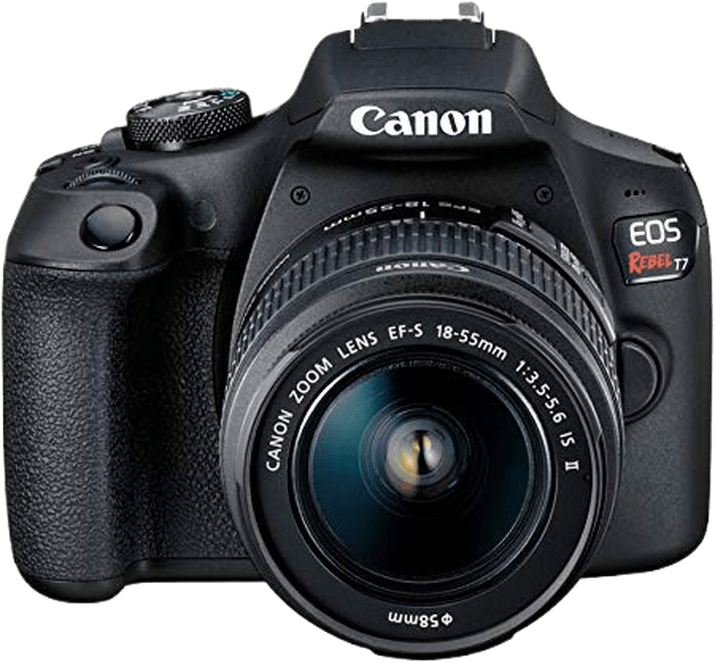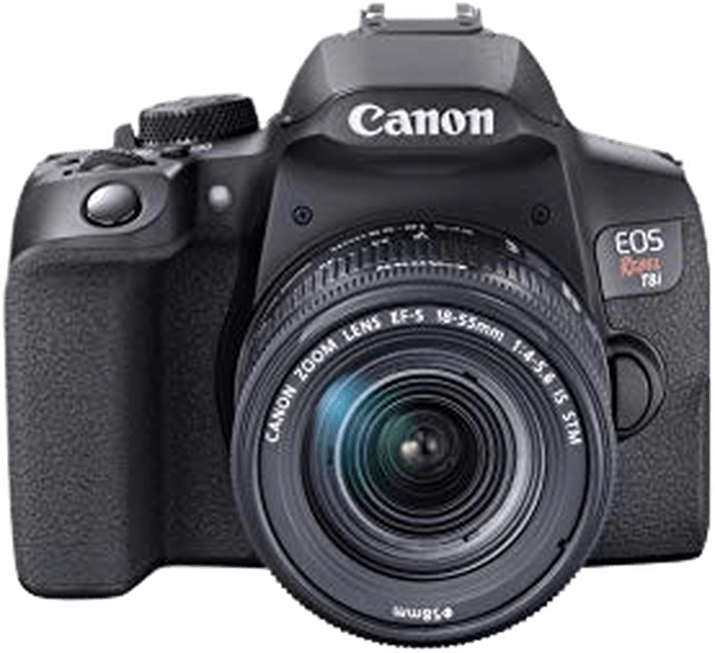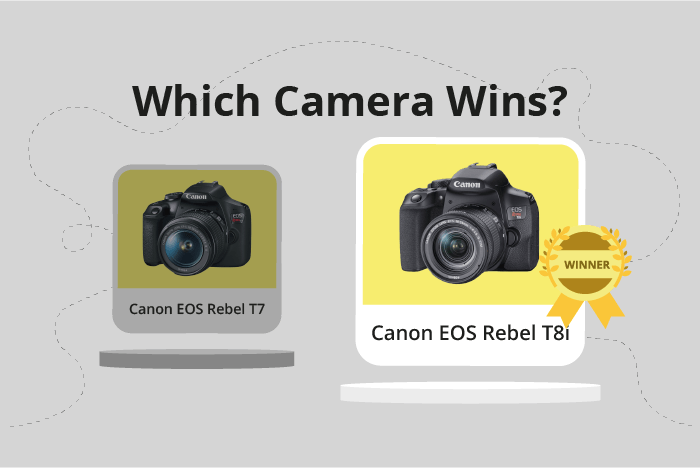Canon EOS Rebel T7 / 2000D vs EOS Rebel T8i / 850D Comparison
Canon EOS Rebel T7 / 2000D

Canon EOS Rebel T8i / 850D

The Canon EOS Rebel T8i/850D outperforms the Canon EOS Rebel T7/2000D with a score of 59/100 compared to 50/100. Both cameras are DSLRs and were released in 2018 and 2020, respectively. They have similar sizes, with the T8i being slightly larger at 131 x 103 x 76mm and lighter at 515g, while the T7 measures 129 x 101 x 78mm and weighs 660g.
The T8i’s higher score reflects its superior performance and features. It offers a more recent release date and a lighter body, making it more portable and up-to-date. However, the T7 has a lower launch price of $550, making it more affordable than the T8i’s $750 price tag.
Considering these factors, the Canon EOS Rebel T8i/850D is the better camera due to its enhanced performance and lighter weight. On the other hand, the Canon EOS Rebel T7/2000D may be a suitable choice for budget-conscious consumers.
Canon EOS Rebel T7 / 2000D vs EOS Rebel T8i / 850D Overview and Optics
The Canon EOS Rebel T8i / 850D narrowly wins in our optics comparison with a score of 57/100, while the Canon EOS Rebel T7 / 2000D receives a score of 56/100. Both cameras share several specifications, including a 24-megapixel CMOS sensor, APS-C sensor size, Canon EF/EF-S lens mount, and lack of image stabilization.
The T8i / 850D outperforms the T7 / 2000D in a few areas, notably with its shooting speed and processor. The T8i / 850D has a shooting speed of 7.5 frames per second (fps), compared to the T7 / 2000D’s 3 fps. This faster shooting speed allows for better action and wildlife photography. Additionally, the T8i / 850D features a more advanced Digic 8 processor, which results in improved image processing and overall performance.
On the other hand, the T7 / 2000D has a higher DXOMARK sensor score of 71, compared to the T8i / 850D’s score of 58. This indicates that the T7 / 2000D may produce better image quality in certain situations, despite its slower shooting speed and older processor.
Taking these factors into consideration, the T8i / 850D is the better choice for those who prioritize shooting speed and overall performance. However, the T7 / 2000D may still be a suitable option for photographers who value image quality and are less concerned with shooting speed. In the end, both cameras offer solid optics, but the T8i / 850D edges out the T7 / 2000D by a narrow margin.
Canon EOS Rebel T7 / 2000D vs EOS Rebel T8i / 850D Video Performance
The Canon EOS Rebel T8i / 850D outperforms the Canon EOS Rebel T7 / 2000D in video capabilities with a score of 83/100 compared to the T7’s 43/100. Both cameras share some common specifications, such as offering Full HD resolution and a maximum video dimension of 1920 x 1080. However, the T8i has several advantages that contribute to its higher score.
The T8i is superior in terms of maximum video resolution, as it offers 4K resolution while the T7 only provides Full HD. This results in sharper and more detailed video footage. Furthermore, the T8i has a higher maximum video frame rate, reaching up to 60fps compared to the T7’s 30fps. This allows the T8i to produce smoother videos, especially in fast-paced situations or when capturing slow-motion footage.
Additionally, the T8i features built-in time-lapse functionality, which is absent in the T7 model. This enables users to create stunning time-lapse videos without requiring additional software or equipment.
On the other hand, the T7 does not offer any significant advantages over the T8i in terms of video capabilities. It has a lower video score, limited resolution, and lacks time-lapse functionality.
Therefore, for users who prioritize video performance, the Canon EOS Rebel T8i / 850D is the clear choice due to its higher video score, 4K resolution, 60fps frame rate, and built-in time-lapse feature. The Canon EOS Rebel T7 / 2000D falls short in these aspects, making it less suitable for those with a focus on videography.
Canon EOS Rebel T7 / 2000D vs EOS Rebel T8i / 850D Features and Benefits
The Canon EOS Rebel T8i / 850D emerges as the winner in the comparison of features with a score of 70/100, while the Canon EOS Rebel T7 / 2000D trails behind with a score of 41/100. Both cameras share some common features, such as a 3-inch screen size, the absence of GPS, and the presence of WIFI connectivity. However, the T8i outperforms the T7 in several aspects, making it a superior choice for photographers.
The T8i boasts a higher screen resolution of 1,040,000 dots compared to the T7’s 920,000 dots, resulting in a clearer and more detailed display. Additionally, the T8i has a touchscreen, whereas the T7 does not. This feature allows for easier navigation and control of the camera’s settings. The T8i also has a flip screen, which enables users to shoot from various angles and positions. Furthermore, the T8i is equipped with Bluetooth connectivity, providing more options for transferring and sharing files.
On the other hand, the T7 has limited advantages over the T8i. It also features a flip screen, but this is the only area where it matches the T8i. The lower feature score of the T7 is indicative of its overall inferiority in comparison to the T8i.
Given the significant difference in feature scores and the advantages offered by the T8i, it is evident that the Canon EOS Rebel T8i / 850D is the better choice for photographers seeking enhanced functionality and superior performance. The T7 may be suitable for those who require only basic features and are willing to compromise on quality for a lower price.
Canon EOS Rebel T7 / 2000D vs EOS Rebel T8i / 850D Storage and Battery
The Canon EOS Rebel T8i / 850D outperforms the Canon EOS Rebel T7 / 2000D in storage and battery with a score of 35/100 compared to 27/100. Both cameras have one memory card slot and accept SD, SDHC, and SDXC memory cards. However, the T8i is compatible with UHS-I cards, offering faster transfer speeds.
The T8i has a longer battery life, providing 800 shots per charge, while the T7 only manages 500 shots. The T8i uses an LP-E17 battery, while the T7 uses an LP-E10 battery. Neither camera has USB charging capabilities.
Despite the T8i’s higher score and advantages, the T7 may still be a suitable option for casual photographers who do not require extensive battery life or faster memory card compatibility. The T8i is the better choice for those in need of longer shooting sessions and faster storage performance.
Canon EOS Rebel T7 / 2000D vs EOS Rebel T8i / 850D – Our Verdict
Are you still undecided about which camera is right for you? Have a look at these popular comparisons that feature the Canon EOS Rebel T7 / 2000D or the Canon EOS Rebel T8i / 850D:

